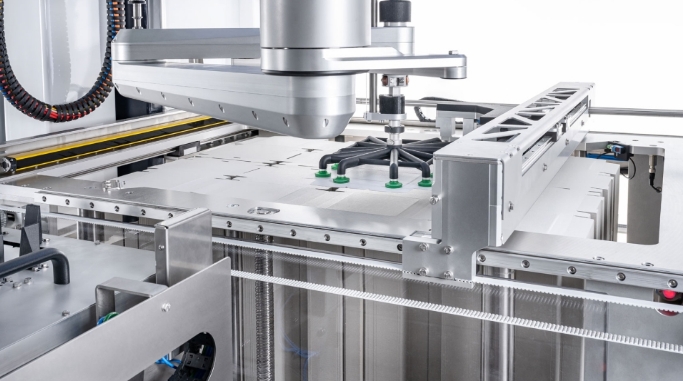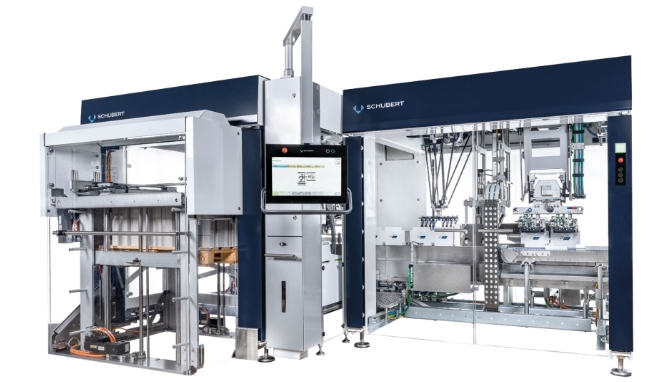Schubert’s TLM Comfort Feeder automates the feeding of die-cut cartons directly from the pallet
2024-03-04
Due to continuing challenges such as high energy costs, rising raw material prices and labor shortages, many economic sectors, such as baking, confectionery, food and cosmetics, are under a strong pressure. Many consumer goods manufacturers are starting to organize their packaging processes more efficiently, which in most cases means automating manual work steps. Intelligent solutions that can be expanded later depending on needs are also in demand. To meet these requirements, modular packaging machines from Gerhard Schubert GmbH offer the greatest possible flexibility. With its TLM Comfort Feeder, the packaging specialist now offers consumer goods manufacturers an extremely compact solution for automating the feeding of die-cut cartons to the packaging machine.
The new TLM Comfort Feeder is ideal for products that are to be packaged in cardboard secondary packaging. It is aimed at companies that want to optimize their packaging process before the machine and are looking for a cost-effective and effective solution. It is also attractive to those looking for a machine with a small footprint and who want to lighten the workload of existing production staff, while prioritizing high packaging performance. Schubert has developed the new TLM Comfort Feeder in response to a previously existing problem: the fact that production delays can occur when the packaging machine’s die-cut carton magazine becomes empty.

When fed directly from the pallet, an F4 robot pulls each die individually from the sheet.
In these cases, machine operators had to react quickly to avoid unnecessary stops. With the new TLM Comfort Feeder from Schubert, this is now a thing of the past. Simply place the pallet with all the complete cut sheets into the machine. The formats are already pre-cut and you only have to join them at predetermined breaking points to form a sheet. Packaging manufacturers can easily supply blank sheets prepared in this way on request, making the usual intermediate sheets on the pallet superfluous. Additionally, the cut-to-size film can be optimized to make the most of the packaging material. In this way, material, resources and costs are saved, while the carbon footprint related to transport is reduced, since the weight is reduced.
Automation frees operators from work
With the Comfort Feeder, the die-cut cartons are fed into the machine in a single lane, which optimizes the performance of the few robots integrated into the machine, allowing them to operate at 60 cycles per minute, that is, processing 60 cartons per minute. .
To remove the die-cut cartons from the pallet, a clamping device fixes the cardboard sheets in place, while an F4 robot removes each die-cut cardboard directly from the plate and places it in a vertical warehouse that serves as a stop. The pallet is gradually raised as the stack of blank sheets is depleted. A camera also monitors the position of the top sheet so that the robot can precisely access each pre-cut piece. Unlike conventional processes, in which production operators have to fill the warehouse with more die-cut cartons at short intervals, the Comfort Feeder operates continuously for up to five hours before a new pallet of cut sheets needs to be placed. in the machine. In times of labor shortage, staff can engage in other activities. The TLM Comfort Feeder is also very easy to operate, even without specialist knowledge, as there is no need to adjust or change the feeders on the machine when changing the packaging format.

Once removed from the cut sheet metal, the flat formats are placed directly into the magazine of the
A6 assembly unit and assembled in a single track at a speed of 60 cycles per minute.
Compact power with high output density in the smallest spaces
In addition to reducing the workload of personnel, the TLM Comfort feeder offers another decisive advantage: it is compatible with the “Power Compact” machine concept. Since the TLM Comfort Feeder always works together with an A6 assembly machine, all lines with this feeder automatically have a high capacity in the smallest spaces. Expanding production to large areas is extremely costly for companies. For this reason, Schubert constantly develops machines under the motto “Power Compact”, built to be very compact and save space thanks to a new process concept and innovative technology, while at the same time demonstrating their full capacity. In addition, smaller machines, with less technology and fewer robots, also mean less maintenance, which in turn saves costs.
A perfect team: the Comfort feeder and the A6 former
In packaging machines with TLM Comfort Feeder, the A6 former takes care of further processing once the die-cut cartons have been inserted. To do this, it extracts each die individually from the bottom of the lung and transfers it to a pusher, which transports it beyond the gluing unit to a folding box. There, a punch sucks up the blank, presses it through the bending box to erect it, and places it into the transport system. The A6 former can easily maintain the high throughput of 60 formats per minute set by the TLM Comfort feeder.
The TLM Power Compact: high performance in little space…

The TLM Power Compact: high performance in little space.
Here, the Comfort feeder is placed in front of a TLM cartoner to package muesli bars.
Modularity for maximum flexibility
The entire process, from the removal of flat formats to assembled packaging, is automated and integrated into a single submachine. While the TLM Comfort Feeder always works with an A6 former, it can also be used without the TLM Comfort Feeder. In this case, a vertical warehouse can be used. Other Schubert packaging machines can be attached for subsequent steps, such as a TLM cartoner for filling and closing cartons. Machines for the above work steps, such as a TLM flowpack packaging machine for packaging products into flowpacks, can also be easily combined with the TLM Comfort Feeder. The modularity of the machine concept provides consumer goods manufacturers with the greatest possible flexibility, as all components of the “Schubert modular system” are compatible and can be combined again and again to create efficient packaging lines. Thanks to the modular design, companies can start by purchasing the packaging function that is most important to them and expand later if necessary. In times of economic hardship, this is an advantage that should not be underestimated.




